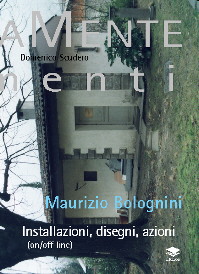Indice
PREFAZIONE
di Mario Casanova e Domenico Scudero
IN SILENZIO E CIECAMENTE.
(MUSEOPHAGIA, COMPUTER SIGILLATI E IMAGING MACHINES DI MAURIZIO BOLOGNINI)
di Simonetta Lux
LA MENTE PROFUSA
di Domenico Scudero
BOLOGNINI E LA DOMESTICAZIONE DEL
SUBLIME
di Mario Costa
GLI ALGORITMI SIGILLATI DI
MAURIZIO BOLOGNINI. TRA SEGNO E SIGNIFICATO
di Giulio Giorello
CAUSALITA' E CONTROLLO NEI
COMPUTER SIGILLATI DI MAURIZIO BOLOGNINI
di Paola Barbara Sega
SMSMS: INFOINSTALLAZIONI E CITTĄ
DIGITALE
di Maurizio Bolognini
NOMADISMO DEL SEGNO
di Angela Madesani
MAURIZIO BOLOGNINI: TRA UTOPIA E
INFOCAOS
di Enrico Pedrini
LA GALLERIA D’ARTE NELL’EPOCA
DELLA SUA RIPRODUCIBILITĄ DIGITALE
di Derrick de Kerckhove
APPARATI
a cura di Luna Gubinelli
Biografia
"The extreme shift from Raptus to the algorithmic language
of Programmed Machines shows the need to combine courageously
the reason for the gesture with the reason for its
sublimation in the autonomous machine. A tension which
is only partly contradictory; a paradox that arises within
aesthetics and Romanticism, in terms of the separation of
art and technology. In the former the gesture and material
withdraw, in the latter it is their organic transcendence
that withdraws. Gesture and thought guide us to an understanding
of the sophisticated meaningful mechanism of
the work in question, which is structured through excessive
alternation between extreme gesture and extreme
absence of movement; perception of the void and filling
up infinity. The sublime lies in the "fullness" of the working
of the instrument, within the programmed computer
where we know the forms of this sublime are in a continuous
state of evolution that cannot be understood except
in evocative fragments. [...] In the invisible drawings produced
by Sealed Computers, which generate images like
hidden thoughts, the technological sublime is imperceptible
like man's mental processes. Only we are conscious
that there is a command, there is a gesture which has set
off the process of imagination. The box of the computer,
stripped of its peripherals, becomes the perfect alter ego
of utopian thinking about form.
Bolognini's work describes an a priori of the gesture and
an effectuality of technology which are unlikely to find
afferent meanings in contemporary art. The mixture of
instinct and intellect is the manifest and objectively valuable
aspect of this artistic work, diffused by the gesture
and commanded by the ideal of a utopian vision of the
human intellect."
(from Domenico Scudero, The profuse mind)
"When I stand before a work by Maurizio Bolognini I feel: of course it doesn’t matter how I
feel, but what does matter is the fact that, contrary to the conviction of what
one would call the de-subjectivised, de-passionalised ambit of this
post-electronic age, I feel.
When I say "it doesn’t matter", this does not mean that Maurizio
Bolognini's work
embodies perfectly the presumed emptiness of meaning and the infinitely multiple
possibility of interpretation. It can in fact mean that, not too old and thus
not yet forgetful as I am (unlike the new unhappy critics),
I remember,
that he makes me remember. […] I see as in a flash the gesture carried out around that time of showing
the unshowable, as in the exhibitions le vide and le plein held
in Paris at the Gallerie Iris Clert by
artists who still thought
that the product and
not the concept
represented
the great future challenge. Maurizio Bolognini, on the other hand, who also
thinks of the present world - techno-productive, hard
and soft - works at a "decisional"
level.
He is "political". He handles
machines, software, contexts and possibly people, constituting a paradoxical pattern of
"modes of use", and only at the end (at the end of the decision and once the
action has been
made) will he perhaps clarify or give a glimpse of the non-sense that belongs as
much to the work as to the appointed place. […]
Certainly
with Museophagia
(the
artist "exhibits" everything that is given in one particular place,
stripping it of its function, then packing it up and exhibiting everything in
other places of the planned tour), with his
Machines
(using
stochastic software to program computers and leaving them to work without
monitors, while - invisibly - creating random images of various square
kilometres) […], Maurizio Bolognini is a thousand times heteronymous: he is at
the same time Erik Satie (what is the form
of your work? the form
of
a pear",
he replied), Marcel Duchamp (Heros Sčlavy: eros is life), Sergio Lombardo ("project
for death by poisoning"), Carlo Emilio Gadda (who,
asked about the tendencies
of
recent literature, replied:
I
tend to
my end, I
tend to
a brutal deformation of the themes which destiny decided to propose to me as
formed things and objects"), etc.
In short, what in the avant-gardes and the neo-avantgardes was the ironic
psychological challenge to mechanism and automatism culminated in the
existentialist years of the twentieth century, in the scandal of the negation of
being and the identified place (man, museum, gallery, city), in Bolognini
becomes something eponymous (himself), the kind reduction of the ensemble of his
calculating machines into a flock, into an entity which is useless and worthless
if we are not there to direct it. A creator, or artist, is a person who
institutes a mode of use of the world or of the machine: responding lightly and
without fear to the bewildering condition which inevitably (and fortunately)
sooner or later presents itself to us.
So don’t close your eyes, please!
Allow the machine its innocent operations - silently and blindly."
(from Simonetta Lux, Silently and blindly)
|

